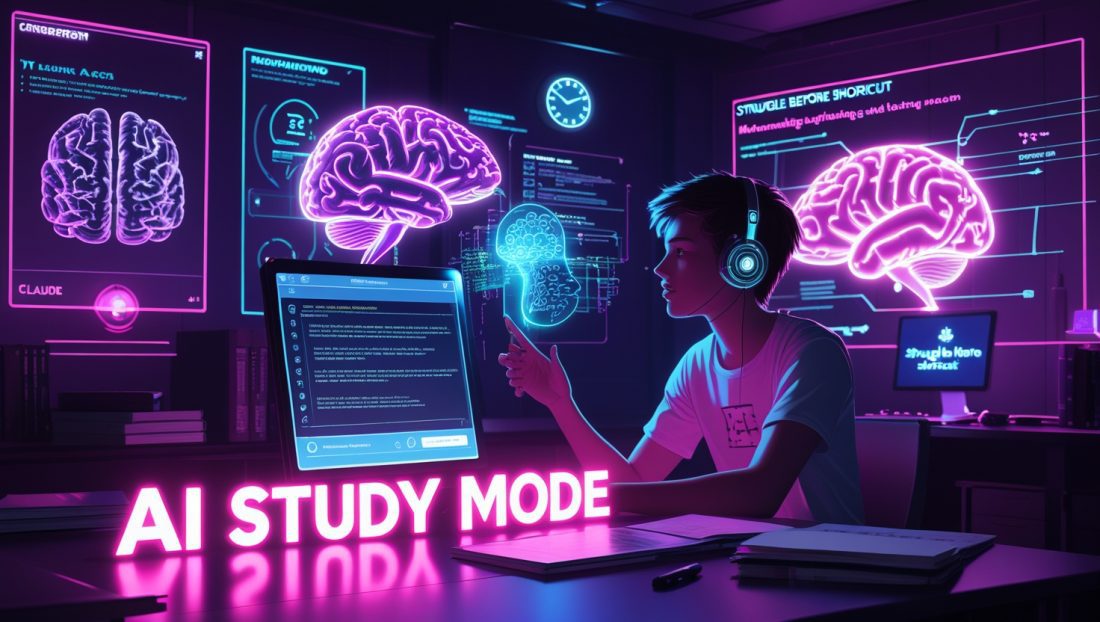OpenAI’s AI Study Mode replaces direct answers with Socratic tutoring, aiming to combat academic dishonesty. Yet students can toggle it off freely, and UK schools report 7,000 AI cheating cases in 2023–24. The tool offers personalized scaffolding but risks misinformation from ChatGPT’s flawed training data. While beta testers praise its 24/7 tutoring, educators question long-term critical thinking impacts.
“It’s like the reward signal of like, oh, wait, I can learn this small thing,” says Maggie Wang, a Princeton student who finally grasped complex math concepts after a 3-hour session with the AI tutor.
OpenAI’s Classroom Gambit
On July 29, 2025, OpenAI launched AI Study Mode for ChatGPT—a direct response to education’s AI crisis. Available immediately for Free, Plus, Pro, and Team users (with ChatGPT Edu coming soon), the feature forces students to work through problems step-by-step instead of receiving instant answers. This counters soaring academic misconduct: UK institutions reported 7,000 proven cases of AI cheating in 2023–24 (5.1 per 1,000 students), up 219% year-over-year.
Similarly, the rise of AI in judicial decisions is forcing courts to rethink fairness and accountability—an issue education now confronts.
Developed with pedagogy experts from 40+ institutions, AI Study Mode uses custom system instructions to simulate human tutors. As OpenAI VP Leah Belsky states: “When ChatGPT is prompted to teach or tutor, it significantly improves academic performance… but as an answer machine, it hinders learning.”
How AI Study Mode Rewires Learning
Socratic Questioning Over Answers
When activated, the tool rejects requests like “Solve this calculus problem.” Instead, it responds: “What’s your current math level? What specifically confuses you about integrals?” This mirrors the Socratic method—probing users to articulate their reasoning before offering tailored hints. During demos, asking about game theory triggered a 5-phase roadmap covering Nash equilibriums to real-life negotiations, with constant knowledge checks.
Socratic prompts are also being explored in industrial AI training simulations to boost operator decision-making.
Cognitive Load Management
Responses are chunked into “scaffolded sections” with bolded key terms and connections between ideas. This avoids overwhelming learners—a technique validated by Stanford’s SCALE Initiative partners. For dense topics like Bayesian probability, it assesses prior knowledge first, then adjusts explanations.
The same scaffolding techniques power AI-driven scientific discovery, enabling researchers to unravel complex challenges in biology and physics.
Battle Against Shortcut Culture
Despite refusing direct answers, students can disable AI Study Mode instantly. As Wired notes, this “glaring problem” undermines its academic integrity goals. One Reddit user described an 11-year-old using ChatGPT to answer “How many hours in one day?”—calling the trend “heartbreaking.” A UK survey found 77% of teenagers use AI for homework, with 20% relying on it regularly.
The $80 Billion Tutoring War
AI Study Mode enters a heated edtech market projected to hit $80.5 billion by 2030. Key rivals:
- Anthropic’s “Learning Mode”: Similar Socratic prompts in Claude’s chatbot.
- Google’s Gemini: Free for students, with guided learning and exam prep canvases.
- ByteDance’s Gauth: Homework-solving app surging during school terms.
Meanwhile, the success of AI-powered content discovery tools in media highlights how personalized guidance is becoming the default in every industry.
OpenAI positions AI Study Mode as an “equalizer”—providing 24/7 tutoring for those who can’t afford $200/hour human tutors. Early tester Praja Tickoo (Wharton) said: “I’d pay for this.” Yet critics highlight a fatal flaw: the AI still trains on unreliable web data. As MIT Tech Review warns, it’s like “a tutor who read every textbook but also every flawed Reddit post.”
In industrial environments, similar flaws have triggered safety concerns, like in the AI false positive sensor crisis, where misinformation led to costly errors.
The Brain Atrophy Dilemma
Teachers report declining critical thinking as students delegate reasoning to AI. “The hardest challenge,” observes Wired, “is resisting the urge to swap out of study mode… and have ChatGPT tell you the answer.”
Neuroscience reveals why: struggle precedes growth. When ChatGPT handles cognitive load, neural pathways for problem-solving weaken. OpenAI CEO Sam Altman dismisses concerns—comparing AI’s disruption to calculators and Google. But educators like Christopher Harris counter: “Will young people develop over-reliance that impedes critical thinking?”
Evergreen Takeaways: Beyond the Hype
Scaffolding Beats Answers
AI Study Mode’s “active learning” approach—quizzes, reflection prompts, and incremental challenges—aligns with Bloom’s Taxonomy. Students who engaged deeply, like Maggie Wang, showed greater retention than those seeking quick fixes.
Scaffolding also underpins AI-assisted disaster response robots, which learn stepwise from terrain analysis to victim extraction.
The Admin Control Gap
Schools currently can’t force AI Study Mode usage. OpenAI acknowledges future tools for “parents or administrators” may be needed.
Institutions are taking cues from AI transparency debates, calling for deeper control and auditability in AI use across sectors.
The Long Game
OpenAI will refine AI Study Mode using student feedback, eventually baking behaviors into core models. Planned upgrades include:
- Visualizations for complex concepts
- Cross-session progress tracking
- K–12 personalization
Disclaimer: Some insights in this article are speculative or illustrative, intended to explore emerging trends rather than predict outcomes with certainty. They reflect current trajectories and available data at the time of writing.
Tutor or Cheat Engine?
OpenAI’s AI Study Mode is a tectonic shift—prioritizing metacognition over convenience. It democratizes elite tutoring strategies, potentially narrowing education inequality. Yet with no enforcement mechanism and ChatGPT’s hallucination risks, it’s half a solution. As UK educators redesign assessments to outsmart AI, the real test isn’t for students, but for institutions: Can they harness AI’s scaffolding without eroding intellectual resilience?
As seen in Singapore’s Robonexus initiative, AI tools thrive when paired with strong institutional frameworks—not just good intentions.
“The ultimate test,” says University of Minnesota tester Caleb Masi, “is whether AI teaches us to ask better questions.”
Subscribe for More: Get our EdTech Disruptors newsletter—weekly insights on AI’s evolution.
